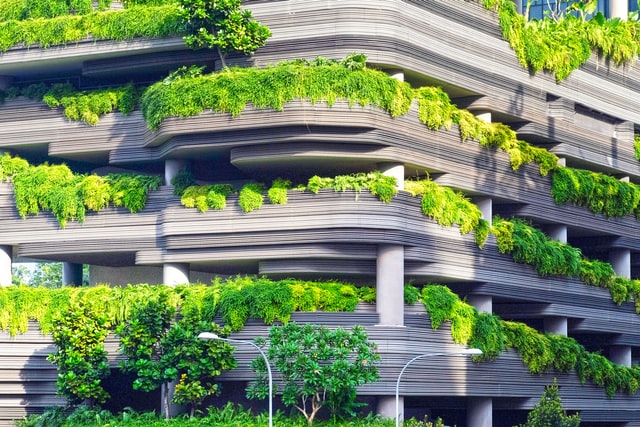Constant heat waves, fires and droughts all around the world. With climate change becoming ever more urgent, companies are trying to find ways to be sustainable while remaining profitable. They’d like to deploy green technologies which could help them remain competitive while reducing their carbon footprint.
UK-based consultancy firm Bionic, which advises companies on how to become more sustainable, has looked at worldwide cities’ pollution levels, electric vehicle uptake, renewable energy usage and more to determine how cities are doing in their efforts to become greener. Bionic reviewed the 40 most populated cities across the globe and scored them using 13 metrics, to discover who was going green fastest.

These metrics included:
- Countries’ land covered by forest and how that has changed since 1990
- Air quality level in each city (0-50 is good, 150+ is not good)
- Countries’ percentage of energy that is renewable
- CO2 footprint per metric tonne (annually)
- Countries’ meat, poultry and milk consumption in tonnes
- Countries’ annual plastic waste in tonnes
- Predicted percentage of worldwide mismanaged plastic waste 2025
- Ozone concentration parts per billion 2015 and ozone concentration change since 1990
- Countries’ number of available sustainability jobs per 100,000

1. Auckland, New Zealand
Auckland is one of New Zealand’s major cities, offering incredible views of the sea and a thriving metropolis for locals and visitors to enjoy. But unlike other large cities across the world, its size hasn’t held it back when it comes to going green.
37.60% of the area is covered by forest, a figure that has actually grown by 6% since 1990. The energy it uses is 35.40% sustainable, while there are 21 jobs in the sustainability industry per 100 people.
Auckland is certainly a city moving in the right direction, lowering its carbon footprint to 5.9 metric tonnes. Its air quality level is 9 – for reference, the lower the number here the better.
2. Stockholm, Sweden
Given that 68.70% of the city of Stockholm is covered by forest, it’s no surprise to see that it’s so green. Sweden has been a big advocate for climate change controls throughout its history, and its capital city is leading the way.
42.24% of all the city’s energy is sustainable, second only behind Sao Paulo where it’s 45%. By 2025, it’s predicted Stockholm will only contribute 0.0016% to the world’s wasted plastic total, a figure everyone should be looking to emulate.
3. Lyon, France
Since 1990, Lyon has seen its forest grow by 20%, and that’s just the start of its journey to becoming a more sustainable city. The quality of the air in the French city sits at 43, which is towards the better end of the spectrum, while by 2025 they’re predicted to only contribute 0.0013% of waste plastic to the world’s total.
4. Copenhagen, Denmark
Copenhagen has work to do to become fully green, but it’s doing it fast. The air quality levels there are currently a little high at 112, but they’re looking to change that with 30.16% sustainable energy and 30 jobs per 100 people within the sustainability sector. The Danish capital has seen its forest grow by 18% over the past 32 years, as more trees are planted to help absorb CO2.
5. Dublin, Ireland
The Irish capital has seen a greater amount of forest growth since 1990 than any of the other cities we analyzed – at 69%, the land is quickly being given back to nature. Its ozone concentration per billion – the amount of the atmosphere taken up by carbon – is only 48, contributing to its good air quality levels of 30.
Further insights
São Paulo, which ranked 34th, capital city has the highest percentage of renewable energy. According to Bionic, 45.02% of energy there comes from sustainable sources, helping the city come back from a history of poor pollution. The city is still covered by 59.40% of forest, but that number has been decreasing rapidly since 1990, with 16% of it being lost. That slump needs to stop if it’s hoping to keep competing on a global climate change stage.
The capital of Europe was ranked 7th with a score of 69.2. Brussels’ residents have a relatively low consumption of beef and chicken consumption compared to Auckland. The city is predicted to produce just 0.0018% of the world’s mismanaged plastic waste by 2025. There are more than 40 sustainable jobs per 100,000 inhabitants
The only UK city to make the top 20, Manchester’s air quality levels are as low as 4, only behind Sydney who score an incredible 3. Manchester benefits from a fully electrified tram network running throughout the city, bringing people together without the need for fuel-powered cars. It’s also seen a 15% increase in forest size since 1990, helping it to leave a relatively low carbon footprint of 33.2 metric tonnes.
The worst city for air quality is Dubai. The city suffers badly from sandstorms and pollution, contributing to its levels of 129.













